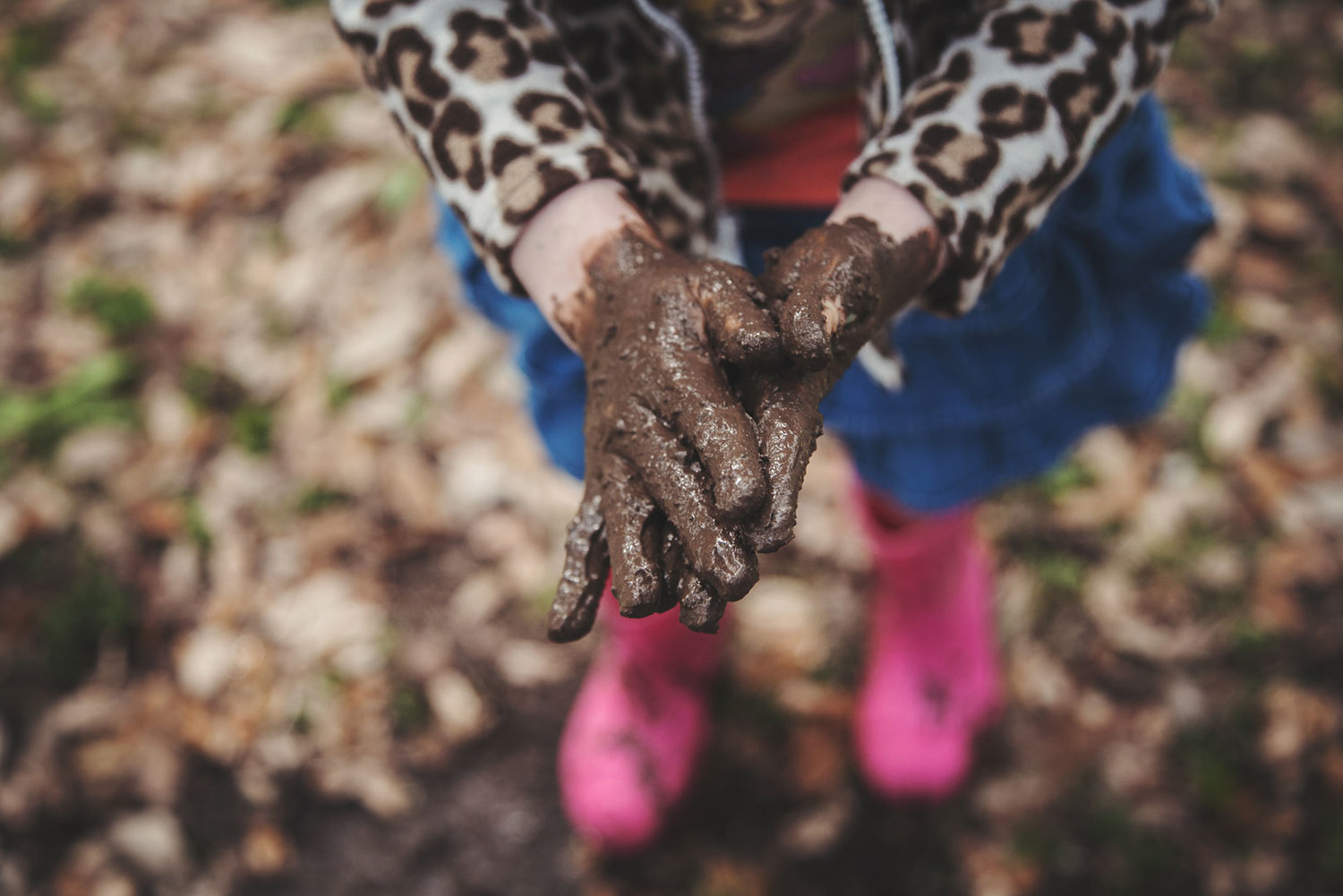Each season, we focus our curriculum and parent-learning series on one essential aspect of early learning. This summer, we focus on sensory development.
Spend time around young kids, and you see that most are drawn to activities that engage their senses. And yet, how each sense works and how our brains process and integrate all of the information gathered by our senses is rather complicated stuff.
While most kids crave sensory engagement, unfortunately they don't always get it. More and more, teachers and parents are noticing that kids struggle with sensory tasks, fidget in school, slip out of chairs—young bodies are crying out for more of what their developing sensory systems need. It's clear we need to understand and prioritize sensory development, but where do we start?
Knowing the basics can make a big impact
Knowing a bit more about the senses, how they work, and why a balanced sensory system is so important for learning can help us better support our kids at home and beyond. Simply being attuned to kids' sensory needs and approaches to sensory experiences can also help us understand our children as learners and as people.
We're thrilled to kick off a series of posts about sensory development and share some of the basic concepts that help guide us in our work with kids and families. We hope these same big ideas can guide you as you support your child's development and learning through outdoor play!
What are the senses?
The "sensory system," in a broad sense, is the part of our nervous system dedicated to receiving and processing information from the world around us. There are several different senses that fit within the sensory system.
Each sense (e.g., sight, smell, touch, etc.) uses different body parts that have specialized sensory receptors—cells that gather a certain type of input from the environment. Those receptors are connected to neurons that bring that type of input to a particular region or regions of the brain to be processed. In turn, the brain then makes sense of the input and triggers a response.
More than "the 5 senses"—We focus on 7!
Many of us remember learning about the five senses in elementary school. The "familiar five" are relatively easy to identify and to connect to visible body parts, so they offer a great starting place for talking about senses with kids.
The number of senses experts reference can actually reach as high as 21! At Tinkergarten, we consider seven senses as we design nature-based, playful, learning opportunities—the familiar five, plus two "hidden" senses called proprioception and vestibular.
Although often "hidden," both proprioception and vestibular are essential and impact how we are able to process and integrate the others. To fully understand how these senses operate requires expertise, but understanding what each is and why it's important is doable, and it can make an huge impact on how you understand and support your child.
- Read more about the basics of proprioception.
- Click here for a similar look at the vestibular system.
Why are senses so important?
"The world is full of magic things, waiting for our senses to grow sharper."—W. B. Yeats
Senses are central to how kids experience the world, how they behave, and how they learn. Here's a bit more about how:
Gathering information: We use our senses to take in information about the world around us. Think of them as our tools for discovery. We also know that the more senses we use, the more complete our understanding of the world becomes, both because more information is collected and because more regions of our brain are engaged in processing and storing the learning we're doing.
"The senses, being explorers of the world, open the way to knowledge."—Maria Montessori
Navigating the world: All of our senses are necessary to navigate the world. Not only do they work together to give us a fuller and richer picture of the world around us, but they help us answer essential questions like, "Where is my body in space? Where is my hand relative to my chest? How can I move without falling? How can I pick this up with the right amount of pressure? Where is danger? Safety? And new things to discover? Without all of our senses activated and working in harmony, it's hard to find answers to these questions, and it becomes very hard to perform day-to-day tasks—and certainly becomes hard to learn.
Attention and focus: Appropriately stimulating the senses turns on the brain and enables children children focus their attention. What could be more central to learning?!
Full participation: Under-stimulating a sense leaves a child seeking more stimulation for that sense. Over-sensitivity in a certain sensory system leads a child to be overwhelmed, and that can lead a child to avoid learning opportunities or to act out in the moment or even well after the over exposure. Either of these extremes—needing more input or becoming overwhelmed by input— can make it hard to fully participate in and benefit from learning opportunities and day-to-day experiences.
What is sensory integration?
Once sensory input is delivered to the brain, the brain has to process it. This processing allows kids to compare the information we're receiving with past experiences, update their knowledge accordingly and, in turn, direct an appropriate, planned response to that information.
In the 1970s, psychologist and occupational therapist Anna Jean Ayres first used the term sensory integration and described it as "the organization of the senses for use." Not only do our brains have to process information, but they also need to process and integrate information from multiple senses at the same time. Ayers's research indicated that some children did not integrate, or combine, the messages from different senses very effectively. When this happens, kids can get overwhelmed, and it can become very challenging for them to plan appropriate responses to sensory input. Or, as Ayers would say, it's hard to put that information to good use.
Ayers and others in the field of occupational therapy have now developed therapies and approaches to support children who struggle with integrating their senses. Their work has also been instrumental in teaching us about how all children develop this capacity and how vital it is to kids' comfort, behavior, and learning.

Nature is the ideal classroom.
Nature truly is the ideal, sensory environment—inherently filled with such supportive learning opportunities. When we are outdoors, we hear sounds all around us, have endless opportunities to move our bodies, and are surrounded with light, color, scents, textures, and more. The surfaces are uneven and there are reasons to look up, down, and all around us. Nature offers the incredible mix of being calming, constantly changing, and stimulating to all of our senses. It simultaneously puts us at ease and at full attention—the dream combination for learning.
"The woods were my Ritalin. Nature calmed me, focused me, and yet excited my senses."—Richard Louv
Why is now such a critical time for sensory development?
Most children strengthen individual senses and develop the ability to integrate their various senses through direct childhood experiences. As childhood is changing, however, kids’ sensory learning opportunities are dwindling.
An increasingly sedentary, screen-heavy lifestyle is actually narrowing our kids’ sensory experiences, which is limiting the development of critical senses that keep kids centered and prepared to learn. Kids who sit all day do not activate their muscles or change their head position—meaning that they are receiving neither the proprioceptive input nor the vestibular input they need. Worse yet, staring at a screen narrows your sensory input to just a portion of visual and auditory, excluding other important senses.
In a world filled with stimulation, we can’t afford to cut kids off from the chances to foster each of these essential senses, and we do them a great disservice when we limit their chances to learn to gather, prioritize, process, and manage a variety of sensory inputs.
So, what can we do?
In short, we can continue to give our kids access to wide range of play experiences that:
- Help kids foster each and every one of these seven senses over time.
- Give kids opportunities to activate multiple senses at once.
- Keep kids in the lead, so kids can decide when to enter into sensory play, how to engage in sensory play, and when enough is enough for them.
Keep learning about the senses!
Indeed, our bodies and our senses are elegant, complicated things. But, just a little knowledge about how they work and how to support the natural sensory development process our kiddos were designed to experience can make a huge impact on our kids’ learning. Keep learning more with us!
- Read about our 9 favorite easy ways to support sensory development.
- Read more about our “sixth sense”—proprioception.
- Read more about a hidden sense on which all others balance—the vestibular system.
Or, come learn with us this summer. Our Sensory series is designed to help your child strengthen and balance their senses. Learn about all of the ways to learn with us at tinkergarten.com/what-we-offer.

